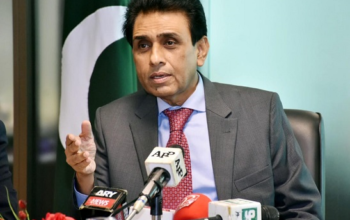ISLAMABAD: Pakistan is facing a disaster within a disaster as diseases spread rapidly and deaths mount following widespread deadly flooding – a crisis worsened by the country’s weak health system and lack of emergency planning, medical experts warn.
Flooded areas stretching over hundreds of kilometres have become breeding grounds for malaria, dengue fever and diarrhoea, with hundreds of thousands of displaced people living out in the open and with little option but to drink unsafe water.
In Sindh – the province hardest hit by the floods – at least 342 people have died from diseases and more than 3.3 million infections have been recorded since July 1, state data shows. Nationwide, there have been 4.4 million disease cases reported.
The flooding – triggered by record monsoon rains and glacial melt, both exacerbated by climate change, scientists say – has killed at least 1,678 people.
But Zafar Mirza, who resigned as a special assistant to the prime minister and from a role as the country’s de facto health minister in 2020, said disease could prove a bigger threat to the country’s health system.
“It can kill more people than those who lost their lives in the flood,” added Mirza, now a professor of health at Shifa Tameer-e-Millat University in Islamabad.
Yet Pakistan’s authorities are ill-prepared to respond to health threats arising out of growing climate-fuelled disasters such as the flooding, Mirza said, adding that the country does not have “a well-thought-out strategy to deal with them”.
Diseases are running rampant in regions such as southeastern Sindh because medical services have been disrupted by the floods and the cash-strapped government is struggling to reach people in need, according to both health experts and state officials.
The World Health Organisation (WHO) has warned about the potential for “a second disaster, a wave of disease and death”, and Pakistan’s planning minister Ahsan Iqbal said last week that “we fear it (the outbreak of diseases) may get out of control”.
Disease and despair
The government is striving to ensure that flood-hit people receive medical treatment and working to stop the spread of diseases, although getting access is difficult, according to Qasim Soomro, Sindh’s parliamentary secretary for health.
He said doctors with support staff and ambulance services were being sent to areas where the water is receding or has done so, with at least 600 mobile teams having been deployed so far.
Also read: Climate change likely worsened floods in Pakistan: study
However, it is tough for the teams to access and support people in places still submerged, the lawmaker added.
Floods have partially or completely damaged more than 1,000 health facilities in Sindh, according to the provincial health department.
People living in far-flung rural parts of Sindh have no access to clean drinking water and health services, said Mirza Ali Azhar, former general secretary of the Pakistan Medical Association (PMA).
“The spread of disease is enormous and unimaginable and the … cases are much higher than (what is) being reported,” Azhar said.
Even the doctors who are treating patients in frontline medical camps can only work for a few hours each day as they must return to cities at night because they have nowhere to stay in flood-hit areas, he added.
“The sick people are not getting continuous medical care, which they require,” Azhar said.
Going forward, he called upon the government to strengthen health infrastructure in disaster-prone areas.
Some tech start-ups and non-profits are trying to play a part in limiting the spread of disease by providing emergency access to clean drinking water.
One start-up, PakVitae, said it had so far distributed 15,000 small-scale water purifiers to flood-affected areas – including Sindh.



